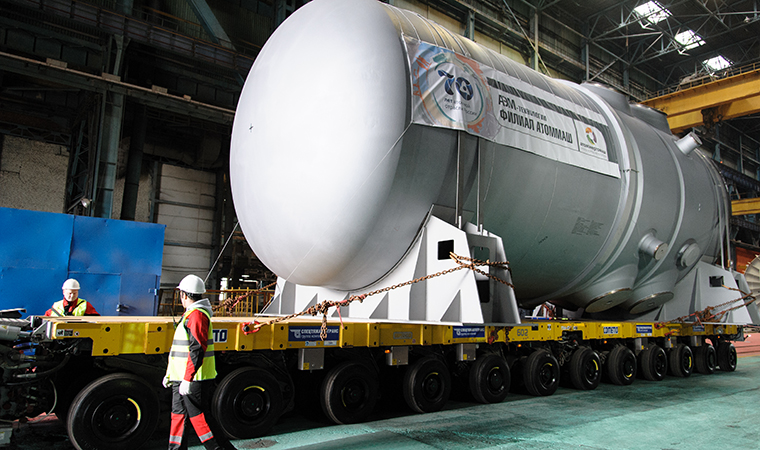
Core equipment to be installed at Belarusian NPP
back to contentsThis was the first step in the installation of the reactor unit’s core equipment. Hydraulic components of the main circulation pump (MCP) were mounted by a Russian subcontractor SEZAM. Mounting operations were performed in strict compliance with the project requirements and within a very short time.
Meanwhile, PetrozavodskMash (a subsidiary of AtomEnergoMash, Rosatom’s nuclear engineering division) manufactured and shipped a set of four MCP casings and spacers to Belarusian NPP Unit 1.
After all necessary welding and assembling, the casings successfully passed hydraulic tests in the presence of the station representatives. This is the most complicated control procedure. The pump casings were tested under the pressure of 250 atmospheres for ten minutes with water heated to 50°C.
After hydraulic tests were completed, the MCP casings were machined, assembled with spacers, painted and prepared for the acceptance by supervisory authorities. The commission members checked dimensions of the casings, particularly threaded connections, verified the marking and went through all the quality checklists.
After the acceptance commission gave its approval, the pump casings were loaded on a vehicle and transported to the customer.
“At present, Belarus has an immense interest in nuclear power since our operating power plants are rather old, and there is something to be replaced everywhere, and nuclear energy is able to replace thermal power plants, where possible,” says Dmitri Maksimovich, an engineer with the Belarusian National Academy of Sciences. “I am very positive about the collaboration with Russia. The Belarusian nuclear power plant is a Generation 3+ project offering the safest design available nowadays. It excludes any human error, so that no person can cause harm. It is thousand times safer than the Chernobyl station because it has a totally different operating principle.”
“Appearance of the nuclear industry in Belarus and construction of a nuclear power plant will have a definitive influence both on the environment and development of the industries having the greatest impact on the nature. I am speaking about power generation in the first place and transport in the second,” says Iya Malkina, First Deputy Minister of Natural Resources and Environmental Protection of Belarus. “We expect that greenhouse gas emissions in Belarus will be declining by 7–10 million tons annually from the current 93 million tons after 2018, the commissioning year of the nuclear station, as estimated by experts of the UN Economic Commission for Europe.” She stressed that the nuclear station will affect neither the nature around it nor the country’s environmental situation in general. “All the lakes in the Grodno Region will remain as pristine as they are today, and all natural reserves in our country will not be affected by the nuclear station construction,” Iya Malkina said.
The Belarusian nuclear power plant is built in the Grodno Region near Ostrovets (Astrovyets). The general contractor is Rosatom’s subsidiary AtomStroyExport. Russia has provided Belarus with a $10bn loan to finance the construction project. Unit 1 of the Belarusian NPP is to be commissioned in 2018, followed by the second unit in 2020.




